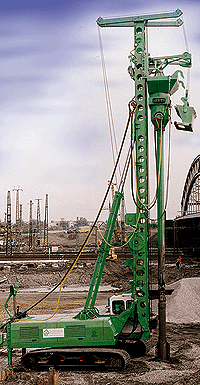Dry Stone Columns
Dry Bottom Feed Stone Columns were invented in Germany in the early 1970’s. They are particularly useful if washout of soil to the surface is to be prevented or where handling of process water for the Wet Top Feed method is problematic.
Dry Bottom Feed Stone Columns have been successfully used on large infrastructure projects like earth dams, highway embankments, airport runways, port facilities and under large industrial structures such as oil tanks and silos. They are a common choice for foundations in liquefiable soils in earthquake prone areas.
The V-Rex
The V-Rex is a state-of-the-art custom built machine for Dry Bottom Feed Stone Columns rigs.
Some of the advanced features include:
Built in data acquisition
Easy mobilization/demobilization
Modular leader extensions
Process control computer, combined with electronic winches, drives rig during column installation on “autopilot”.


